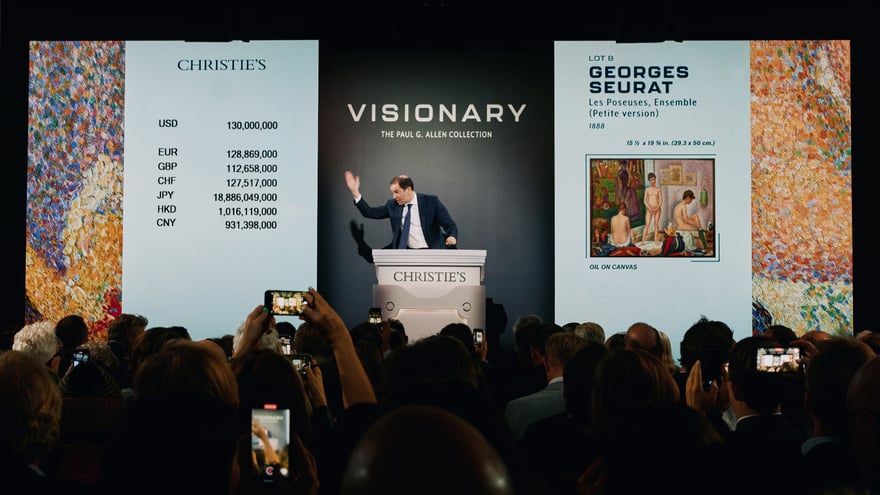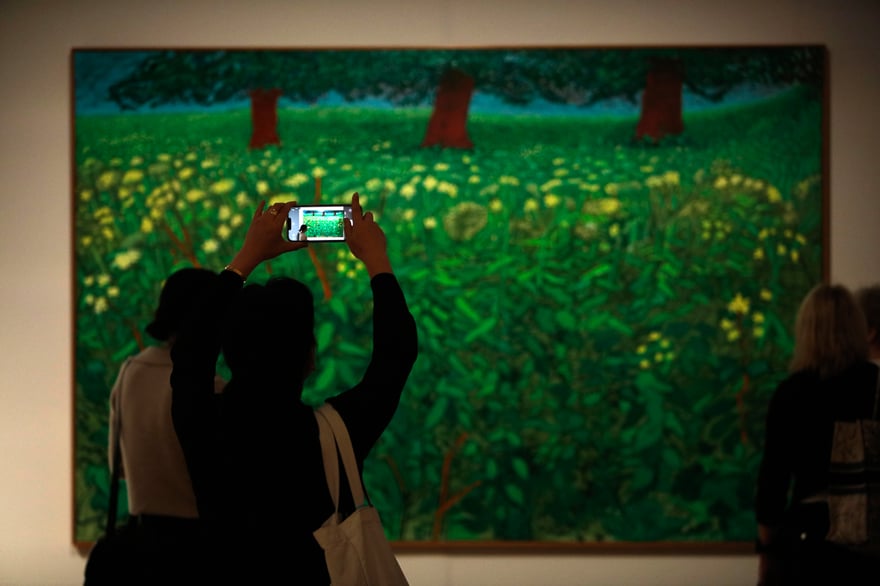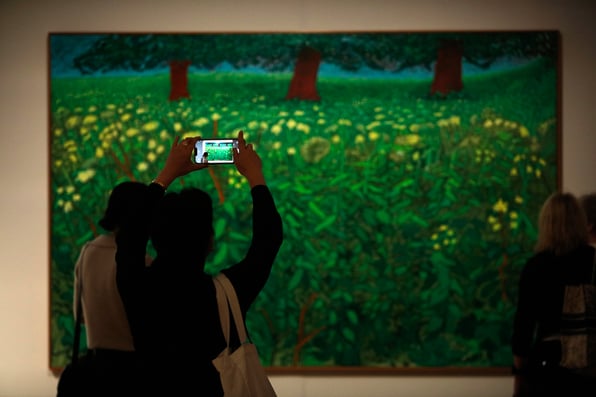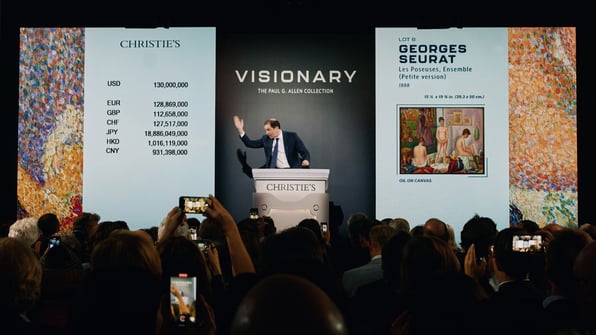Did Paul Allen's Provenance Pay Off?
LiveArt After Action Report: The Paul G. Allen Collection Day sale (Christie’s)
Total: $115,863,500 with 100% sold (95/95)
Composition of Results: 67% above/ 23% within/ 10% below estimates
Aggregate Low Estimate: $58,538,000
Aggregate Hammer: $94,025,000
Hammer Ratio: 1.60
Average Lot Value: $1,291,616
What about those crowds? One of the central questions surrounding the astonishing $1.6 billion Paul Allen collection is whether the Microsoft founder's fame would appeal to collectors as provenance. Christie’s was gratified to see lines form in front of the auction house’s galleries over the viewing period. The last time that happened was five years ago when Christie’s sold the Leonardo. Allen’s collection might not have over-performed as much as that single lot. But it did over-perform.
A name to conjure with? Art collectors are not the general public. Though fame does add to value for both the public and collectors. Christie’s saw that in the Yves Saint Laurent/Pierre Bergé sale in 2009 which was a frenzy of art buying but also celebrity souvenir buying. Everything sold well above the estimates, including some rare categories that YSL collected but few others knew or understood. (The YSL sale had the added surprise value of having taken place during the nadir of the global financial crisis in 2009.) Nine years later, Christie’s watched it happen again with the David Rockefeller sale. It was filled with a mix of superb art works (and some that were less superb but sentimental favorites) and the contents of Rockefeller’s various homes. It all sold above the estimates. Everyone wanted to have an item they could say belonged to the Rockefeller family.
Rockstar or plain old rich guy? Despite the crowds, it doesn’t appear that buyers were chasing after a talisman of Paul Allen. How can we tell? The so many of the Evening sale lots were rare examples of extraordinary works that Allen bought for market prices. As famous as Rockefeller was, the painting by Diego Rivera that Allen bought from the Rockefeller sale for $9 million went up by 55% over just four years. It sold for $14 million in the Evening sale. That would appear to suggest Allen’s provenance added a great deal of value. His Cézanne, Klimt, Gauguin and Monet all performed far better than inflation, too. But they may not have out-paced art market inflation, meaning,—with the exception of the Rivera—most of the works that saw outsized gains in their auction prices were bought in the late 1990s or early 2000s which was before art prices rose dramatically.
It’s the estimates, stupid: Day sale performance offers some clues to the question of Allen’s provenance—though the solution may tell us more about Christie’s marketing than Allen’s market appeal. Based on the raw numbers, the Day sale appeared to be stronger than the unprecedented $1.5 billion Evening sale. The hammer ratio for the sale was a very robust 1.6. But a closer look at the lots and numbers suggests the estimates were structured to attract bidders and reassure them that the works were accessible.
Top Lots
Allen bought Sam Francis’s Red No. 1 in 2016 for $4.4 million. It was estimated in the Day sale at $2.5 million but sold for $6.7 million.
Jacques Lipchitz’s Figure made a record at $4.3 million in the Day sale. It had last been at auction in 1989 when it sold for $1.54 million. Adjusted for inflation, that would be $3.7 million today. Tastes have changed but maybe not enough to support the $700,000 low estimate which was half what the sculpture sold for four decades ago. As it turned out, the market was only willing to give Lipchitz’s record-setting work an additional 15% above inflation.
A second Lipchitz sold for $693,000, right in line with prices for his other work.
Frank Stella’s Cinema di Pepsi from 1966, on the other hand, was bought in 2007 for $2.39 million. It was estimated at $3 million which is a slight 15% discount from the inflation-adjusted $3.44 million the purchase price would equal today. It ended up selling for a solid $5.5 million.
Alexander Calder’s tiny 6-inch table-top stabile was auctioned in 2001 for $160,000. By the Allen Collection sale it had appreciated more than 10-fold to make $1.86 million. But the larger Disques Verticales from 1948 sold for $4.5 million against a $2.5 million estimate. A quick review of Calder prices for works of a similar size reveals that price to be strong but not out of register. Another table-top work, Two-Toned Moon, saw the slightest appreciation from its $2.4 million 2017 purchase price when it sold for $2.7 million in the Day sale.
Most Dynamic Lots
Alden Mason is a name that mostly causes head scratching. So putting a low estimate on the work isn’t unjustified. But the artist, who taught for 30 years at the University of Washington and died in 2013 at 93 years old, has a track record, including a 1974 work that sold earlier this Summer for $162,500 at Revere Auctions. To be fair, that work had an even lower estimate than the one Christie’s put on Sweet Encounter. Mason’s former student Chuck Close had interested his dealer Allan Stone in the painter’s work. Mason is also well represented in Seattle by Greg Kucera gallery. So the $189,000 paid in the Day sale is hardly an aberration even if it is a strong price for the artist.
Mildred Thompson’s work has little in the way of public auction records to orient the estimates. Nevertheless, support from Galerie Lelong, which represents the estate (Thompson lived in Germany much of her adult life), and collecting foundations around the country would have suggested the $138,000 selling price was not out of reach for String Theory 4, one of the artist’s works based on “the fields of science and sound.”
Li Huayi’s Landscape from 2008 was estimated at $120,000 even though similar works have sold for $500-600,000 on several occasions over the last eight years. The final selling price of $819,000 is hardly unexpected.
Y. Z. Kami’s large portrait Untitled (Maryam) from 2007 was estimated at $25,000 even though a similar work in size and imagery was sold at Bonhams two years ago for $150,000 which is almost exactly what Christie’s work made.
Two small works on paper by conceptual painter Mark Tansey were also strong performers. Literalists Discarding the Frame from 1992 sold for $119,700, nearly the same price as a slightly larger work on paper that sold in March of this year for $107,100. Intermission, the surprise hit from 1992 that sold for $151,200 was unexpected but the $40,000 estimate seemed to be aiming intentionally low.





.jpg?width=596&name=Georges%20Seurat%2c%20Les%20Poseuses%2c%20Ensemble%20(Petite%20version).jpg)